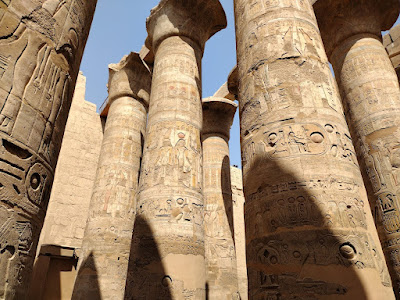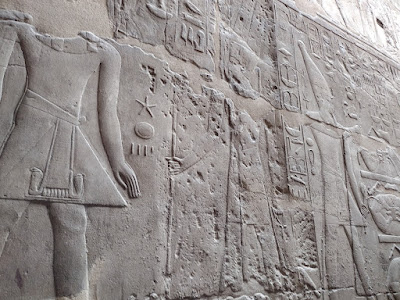We received a wake-up call at 4:30 AM on our last morning at the Cairo Marriott.
After setting our luggage outside our room, we headed down for the early continental breakfast, which turned out to include a chef preparing fresh eggs to order, so not exactly roughing it.
Our group gathered in the lobby to take a bus to the airport. Every time we boarded the bus, we found a list prepared by our guide Fawzy assigning seats, which is a very good system. We moved around to different spots throughout the tour, avoiding any problems over time with some staking out what for some reason might be preferred seats.
The flight to Luxor took about an hour. We had the usual long wait for luggage, but soon we were off to the Temple of Karnak.
Pharaohs ruled Egypt for about 3,000 years, basically from the start of "history" (anything before a written record is by definition "Prehistoric") to the early Roman Empire, when Egypt's Cleopatra took her own life.
Because that is such an enormous span of time, historians have designated three eras, simply called the Old Kingdom, Middle Kingdom and New Kingdom, with New being a relative term still ending before Jesus Christ was born.
Our time in Cairo had focused on the era of the magnificent stone Pyramids, which was the Old Kingdom.
The Old Kingdom collapsed, probably devolving into infighting among contenders to the throne.
Some theorize that spending for massive Pyramids and treasures buried with the Pharaohs drained the wealth of Egypt, leading to this unrest. Others claim that it was the lack of building a major public works project like Pyramids resulting in unemployment, with idle people having time to stir up trouble.
Whatever the case, eventually a new great Pharaoh arose in the ancient city of Thebes and united Egypt again under his rule.
Pharaoh Ahmose I credited Amun, the local god of Thebes, for his victory over the Hyksos, who were foreign rulers from the Levant. It is unclear exactly who the Levant rulers were, but they came from the area now encompassed by modern-day Israel, Jordan, Syria and Lebanon. Some think these invaders were Canaanites, while others believe they were Israelites.
The line of Pharaohs that arose from Thebes in that era claimed to have been selected by Amun and essentially to be gods themselves, descended from Amun.
Somehow, Amun morphed with the god Ra to become Amun-Ra.
Amun-Ra was more popular than The Beatles --- as a time-travelling John Lennon might have said --- for Egyptians.
Rather than building Pyramids, this new batch of Pharaohs devoted great riches to embellishing the Temple at Karnak and the nearby festival grounds in Luxor.
Our guide Fawzy said that we could assume that the inner sanctums were the oldest, and that they kept building newer sections over the ages, but I have also learned that Pharaohs remodeled the temple literally in their own images.
For example, they would chisel out the name of a prior Pharaoh and write their own name instead, or change the face of a god or Pharaoh to reflect the current leadership.
They felt justified in doing this because as the current Pharaoh, they had inherited the royal Ka, or essence of being, so they essentially were the new god. And you thought Joe Biden and Donald Trump had big egos!
Not only did Pharaohs replace names and faces in the art, but sometimes Pharaohs replaced entire shrines and buildings. As to how Egyptologists figure all of this out from rubble to rebuild is beyond me.
Something else I could not fathom is the logic of why the Pharaohs built so many massive columns so close together. After all, as a modern husband I have watched the Property Brothers increase the value of older properties by creating open floorplans.
Obviously, a much different aesthetic was in play in ancient Egypt, but these old structures are nonetheless awesome, and I guess that is the intent: to inspire awe.
I must confess that often my mind was more concerned with looking at the structures and finding shade than setting my brain to record exactly what was being said about the long line of different Pharaohs.
Regarding the structures, I recall Fawzy pointed out that while there are many amazing historical sites in Egypt, lots of artifacts and full structures were carried away by conquerors and now reside in places like the British Museum.
At Karnak, in addition to the main temple for Amun-Ra, there is a second smaller temple for his wife Mut (also called Amunset) and another smaller temple for their son Khonsu, so that's also a holy trinity of sorts.
It also has the tradition of a holy mother, not unlike that found in some Christian sects that emphasize the importance of the Virgin Mary.
As to whether these are coincidences, selective perceptions or related to some deeper truth is for you to decide for yourself.
Once a year, however, the "Inundation" must arrive to bring prosperity to Egypt for another year.
The Season of the Inundation, of course, was the annual flooding of the Nile, which would bring them another year of abundant food and all that entails.
Scientifically speaking, we know the Nile was going to flood no matter what rites were performed by the priests, Pharaoh and worshippers, but who wanted to take that chance?
Especially when they could celebrate in Luxor with the spectacular Festival of Opet.
The three gods were paraded along a 1.7 mile route lined with ram-horned sphinx statues, a dedicated road from the Temple of Karnak to the celebration grounds in Luxor.
With the common people not being worthy to see the actual statues of the gods, the priests put the statues into barks, which were boats with long handles for the priests to parade them into town, all the time cheered by the worshippers who lined the path.
People would shout out questions, and sometimes the gods would answer by going forward or backward, which of course would have been whatever the priests carrying the barks did, unless you believe in Ouija Boards.
The Pharaoh would play some public ceremonial parts to get the blessing of the gods.
Then there would be a huge party in Luxor, with lots of drinking and presumably sex, based on the small but hugely erect statues of the fertility god Amun-Min displayed in the gift shop of our cruise ship.
Speaking of the cruise ship, we boarded M.S. Queen of Hansa for lunch after our tour of the Temple of Karnak. After two hour in 100 degree heat of that open-air museum, we were ready for an air-conditioned break.
While the optional afternoon felucca boat ride excursion sounded tempting, we just wanted to eat lunch and then relax before heading over to nearby Luxor to see the festival grounds.
Evening temperatures were cooler, and we were fully refreshed to explore the wonders of Luxor.
Alexander III of Macedon had been educated by Aristotle, so he knew about the glories of Egypt. Egypt by then had been conquered by the Persians.
Alexander had been told by his mother Olympias that his real father was the Greek god Zeus, who had struck her womb with a lightening bolt.
Still mortal, Alexander died while still a young man. Had he lived, it would be a different world today.
Alexander's sprawling worldwide empire was divided among three generals, one of whom was Ptolemy, who would rule Egypt.
While there are other Pharaohs associated with Luxor, including Hatshepsut, a woman Pharaoh whose temple we would visit later in the trip, Alexander is so close to the end of the Pharaohs that I decided to follow through to the last great Pharaoh, who was also a woman and is well-known.
While that practice seems odd, apparently not only was it common for Pharaohs (unclear if it was a ceremonial wedding or ... yuck!!!), but Cleopatra was actually the seventh queen in the family tree named Cleopatra destined to marry a Ptolemy.
Cleopatra, however, was very well educated and smarter than Ptolemy XIII. Unlike other Ptolemies, she had traveled through Egypt to tour its wonders and learn about its culture. Cleopatra was the first in the Ptolemy line to learn the Egyptian language.
She looked to the larger picture and realized rather than marrying her brother and paying tribute to the Roman Empire with the vast wealth still generated by the Nile Inundation, there was a better way forward for her and Egypt. She would rather rule at the side of the Roman general in Egypt, who held the real power.
Cleopatra reigned over Egypt with Roman Julius Caesar, who could resist neither the allure of Cleopatra nor the ego-trip of being considered to be a god.
Cleopatra accompanied him to Rome in glory, all of which was backstory for the Ides of March. Their son Caesarion became her co-ruler as Ptolemy XV after Julius Caesar was assassinated by Roman Senators.
Cleopatra had a subsequent relationship with Caesar's successor, Marc Antony, which ended tragically. Her son Caesarion was killed by Julius Caesar's nephew Octavian within days of Cleopatra's suicide, in August of the year 30 B.C., and that was the last of the Pharaohs.
Karnak










































































No comments:
Post a Comment